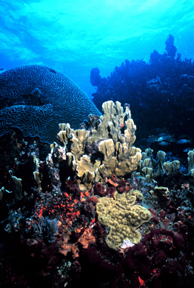 At the dawn of
the industrial revolution, the concentration of carbon dioxide in the atmosphere
was 280 parts per million; today, it is 380 parts per million. Given the amount
of carbon dioxide emitted in the past 200 years, however, scientists estimate
the atmospheric concentration would be double if it were not for the oceans
soaking up the excess. But marine life may now be seeing the effects of this
change in ocean chemistry.
At the dawn of
the industrial revolution, the concentration of carbon dioxide in the atmosphere
was 280 parts per million; today, it is 380 parts per million. Given the amount
of carbon dioxide emitted in the past 200 years, however, scientists estimate
the atmospheric concentration would be double if it were not for the oceans
soaking up the excess. But marine life may now be seeing the effects of this
change in ocean chemistry.High acidity in the world’s oceans may be threatening coral populations, such as those in the Florida Keys National Marine Sanctuary. Photo by Thomas K. Gibson/Florida Keys National Marine Sanctuary.
“Our oceans may be doubly besieged,” says John Raven of the University of Dundee, United Kingdom, who is chair of the working group for an investigation by the Royal Society (the U.K. academy of science) launched in August. “The same pollution that we believe is heating the world’s oceans through global warming is also altering their chemical balance.” Indeed, ocean pH has dropped by 0.1 units (thereby increasing acidity) since pre-industrial times due to increasing atmospheric carbon dioxide concentrations, says Royal Society working group member Ken Caldeira of Lawrence Livermore National Laboratory’s Climate and Carbon Cycle Modeling Group.
The increasingly acidic ocean could be harmful for marine organisms, especially corals and those with hard calcium carbonate shells (calcite and aragonite). Acidic conditions not only dissolve calcium carbonate but also make less of it available for animals to produce shells and skeletons. Because carbon dioxide equilibration takes place at the air-water boundary, researchers say surface waters will be the most affected, but the deep ocean will not be immune to the effects of acidification.
“Surface waters are not those just at the immediate surface but all shallow waters, where corals are found, and where water is mixed from surface to bottom,” says Katherine Richardson, a marine ecologist at the University of Aarhus, Denmark, who studies carbon cycling in the oceans. She adds that in regions such as the North Atlantic, where sinking surface water drives ocean circulation, water with increased carbon dioxide and therefore decreased pH would be able to reach great depths.
The Royal Society review, expected to be completed by sometime next year, was prompted by some recent reports of adverse effects on marine organisms, as well as by controversial proposals to remove carbon dioxide from the atmosphere and sequester it into the oceans. “There have been just a few studies on the effects of ocean chemistry changes on marine biota, but those first studies suggest that a lot of marine biota is very sensitive to changes in ocean chemistry,” Caldeira says.
Some studies found that animals with body cavities open to the water, such as squid, have difficulty transporting oxygen through their systems when water pH decreases. A 2004 Japanese study found that bottom-dwelling organisms, such as nematode worms, can die when high concentrations of carbon dioxide are pumped into the sediment. Another Japanese study found that sea urchin reproductive success decreases with a drop of just a few tenths of a unit in pH. And a Hawaiian study found that more mobile organisms avoid undersea volcanic plumes of carbon dioxide, suggesting that certain animals have a way to sense and avoid poisonous levels of carbon dioxide, and also suggesting that sequestered carbon dioxide perhaps would not affect all organisms equally.
The ultimate success of sequestration schemes, however, will depend on the effects of carbon dioxide in the water, which the Royal Society study will address, as well as the logistics of how it is sequestered — for example, whether it is free or bound in some other form, such as organic material. Some researchers say that the problem of ocean acidification will only worsen if carbon dioxide emissions continue at current levels. Models show that a doubling of atmospheric carbon dioxide concentrations, the limit deemed acceptable by some global climate change policies, would result in a further drop in ocean pH of 0.26 units.
In a 2003 Nature study, Caldeira and colleagues found that ocean pH could drop by as much as 0.77 units by 2300, if carbon emissions continue unchecked. Except for extreme events, such as the impact at the Cretaceous-Tertiary boundary and methane hydrates degassing during the Eocene, that is more acidic than the ocean has been in the last 300 million years, Caldeira says. “It’s been many millions of years since there’s been a change in ocean chemistry comparable to what we’ll be doing over the next few centuries.”

